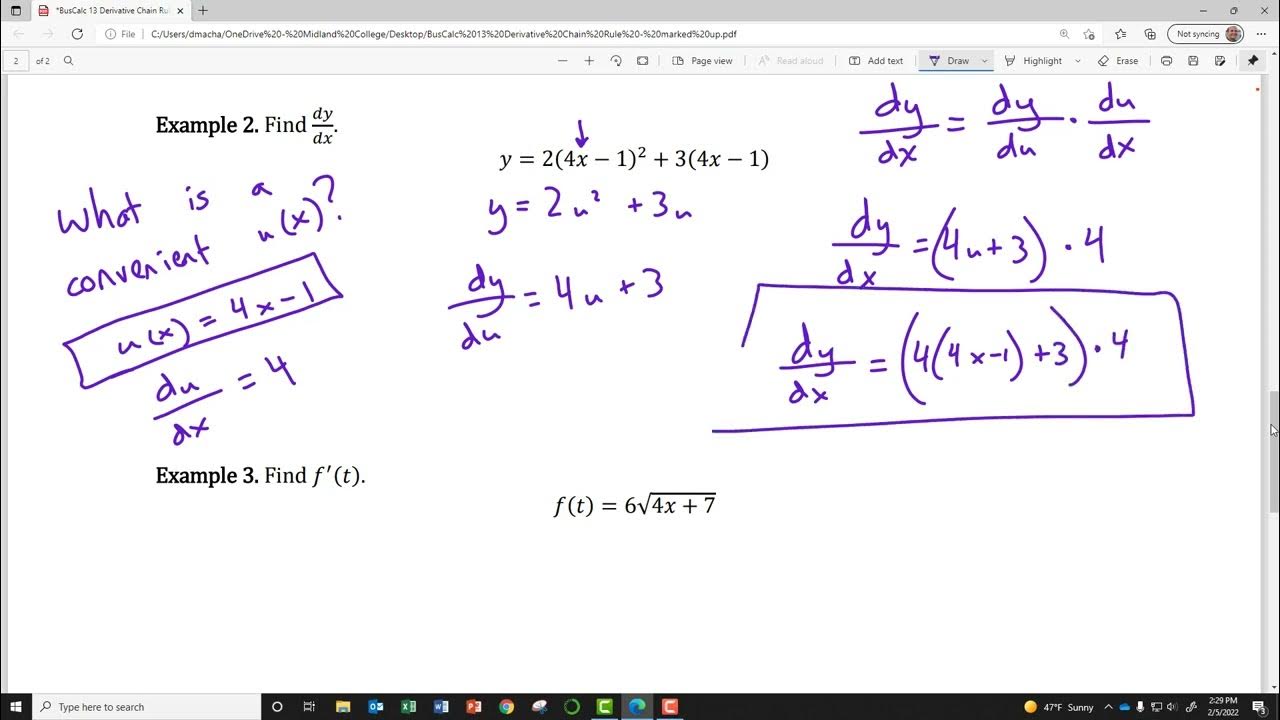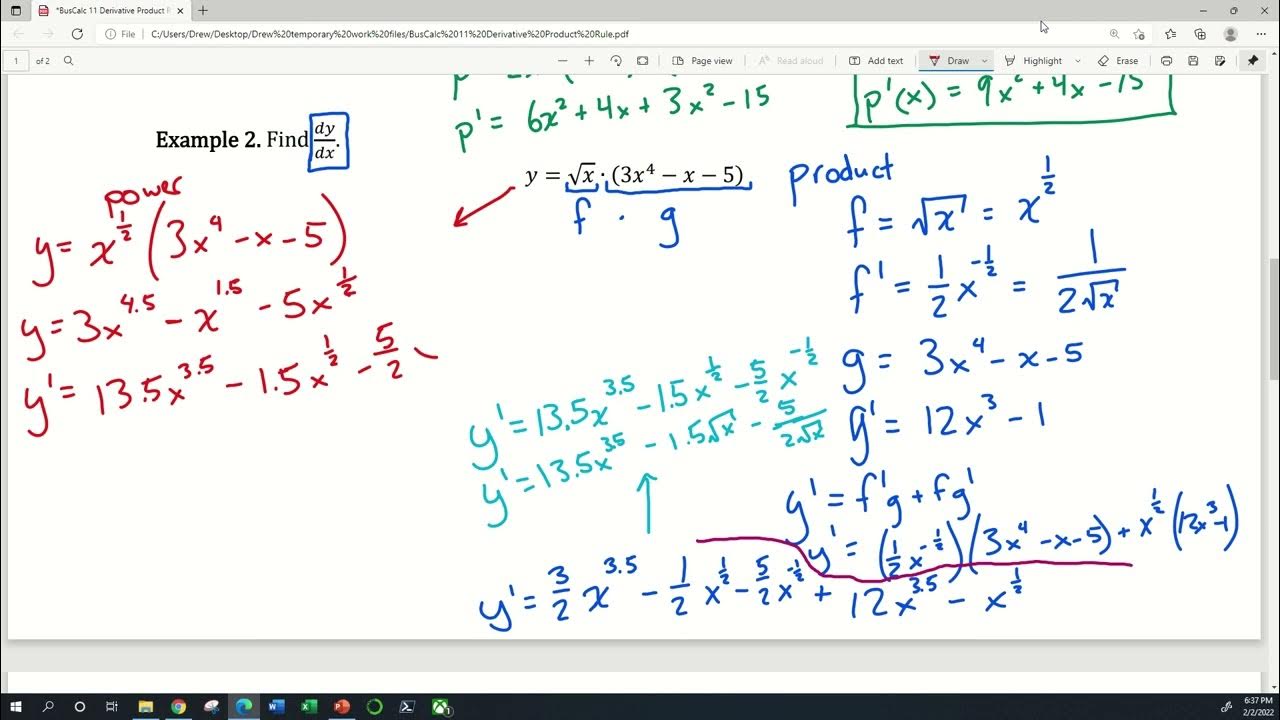Worked example: Derivative of ÃÂ(3x_-x) using the chain rule | AP Calculus AB | Khan Academy
TLDRThis video script introduces the concept of the chain rule in calculus, explaining its abstract formula and demonstrating its application through a concrete example. The chain rule is used to find the derivative of a composite function, expressed as f(g(x)). The video walks through the process of defining functions f and g, applying the chain rule to find f'(g(x)), and then differentiating the inner function g(x). The example involves differentiating the square root of (3x^2 - x), and the video clearly illustrates each step, making the concept accessible and engaging for learners.
Takeaways
- 📌 The video begins with an introduction to the formula for the chain rule in calculus.
- 🔢 The chain rule is used to find the derivative of a composite function, expressed as f(g(x)).
- 🎨 The presenter emphasizes the importance of accurate use of colors to represent functions and their derivatives.
- 🚀 The goal is to calculate the derivative of f(g(x)) with respect to x, which the chain rule states is f'(g(x)) * g'(x).
- 🌟 An example is provided to illustrate the application of the chain rule: finding the derivative of the square root of (3x^2 - x).
- 📌 Functions f(x) and g(x) are defined to facilitate the application of the chain rule to the given example.
- 🔍 The derivative of f(x) is found using the power rule, resulting in f'(x) = 1/(2*x^(1/2)) or f'(x) = x^(-1/2).
- 📈 The derivative of g(x) is calculated as g'(x) = 6x - 1, using the power rule for each term in g(x).
- 🧩 The final derivative is obtained by multiplying f'(g(x)) * g'(x), which is 1/2 * (3x^2 - x)^(-1/2) * (6x - 1).
- 📝 The process demonstrates the step-by-step application of the chain rule and the power rule in calculus.
Q & A
What is the main topic of the video?
-The main topic of the video is the chain rule in calculus and how to apply it to the derivatives of composite functions.
How is the chain rule expressed mathematically?
-The chain rule is expressed as the derivative of the outer function with respect to the inner function, multiplied by the derivative of the inner function with respect to the variable x.
What is the notation used to represent a function composed of two functions?
-The notation used to represent a function composed of two functions is f(g(x)).
What is the example function given in the video?
-The example function given in the video is the square root of (3x squared minus x).
How are the functions f(x) and g(x) defined in the example?
-In the example, f(x) is defined as the square root of x, and g(x) is defined as 3x squared minus x.
What is the derivative of f(x) with respect to x?
-The derivative of f(x) with respect to x is (1/2)x to the power of negative 1/2, which is derived using the power rule.
How is the chain rule applied to the example function?
-The chain rule is applied by first finding the derivative of the outer function f with respect to the inner function g(x), and then multiplying it by the derivative of g(x) with respect to x.
What is the derivative of g(x) with respect to x?
-The derivative of g(x) with respect to x is 6x - 1, found by applying the power rule to each term in g(x).
What is the final expression for the derivative of the example function using the chain rule?
-The final expression for the derivative is (1/2)(g(x)) to the power of negative 1/2, times (3x squared - x), times (6x - 1).
How does the chain rule help in understanding the behavior of composite functions?
-The chain rule helps in understanding the behavior of composite functions by allowing us to find the derivative of a complex function by breaking it down into simpler functions and analyzing their individual and combined effects on the derivative.
What is the significance of the chain rule in calculus?
-The chain rule is significant in calculus as it is a fundamental tool for differentiating composite functions, which are common in many real-world problems and advanced mathematical concepts.
Outlines
📚 Introduction to the Chain Rule and its Application
This paragraph introduces the concept of the chain rule in calculus, emphasizing its importance in determining the derivative of composite functions. The speaker begins by explaining the abstract formula for the chain rule and then illustrates its application through a concrete example. The example involves finding the derivative of the square root of (3x squared - x) and defining functions f(x) and g(x) to represent this expression. The process of applying the chain rule is detailed, showing how to calculate the derivative of the outer function with respect to the inner function, and then the derivative of the inner function with respect to x. The explanation is enriched with the use of color to keep track of variables and maintain clarity throughout the process.
🔢 Conclusion and Review of the Chain Rule Application
In this paragraph, the speaker concludes the application of the chain rule from the previous example and reviews the key steps involved. The focus is on summarizing the process of applying the chain rule, which involves taking the derivative of the outer function with respect to the inner function and then multiplying it by the derivative of the inner function with respect to x. The speaker reiterates the use of the power rule in this process and highlights the final result, which is a combination of the derivative of the outer function and the inner function. This paragraph serves as a recap, reinforcing the understanding of the chain rule and its practical use in calculus.
Mindmap
Keywords
💡Chain Rule
💡Derivative
💡Composition of Functions
💡Power Rule
💡Square Root
💡Function
💡Differentiation
💡Inner Function
💡Outer Function
💡Rate of Change
💡Slope
Highlights
The video begins with an introduction to the chain rule formula.
The chain rule is applied in the context of a concrete setting, using a composition of two functions.
The expression f(g(x)) is used to represent a function composed of two other functions, f and g.
The goal is to find the derivative of the composed function with respect to x.
The chain rule states that the derivative of the composed function is the product of the derivative of the outer function with respect to the inner function and the derivative of the inner function with respect to x.
An example is provided to illustrate the application of the chain rule, involving the derivative of the square root of 3x^2 - x.
Functions f and g are defined to represent the composition of f(x) as the square root of x and g(x) as 3x^2 - x.
f(g(x)) is calculated by substituting g(x) into the function f(x).
The derivative of f(x), denoted as f'(x), is found using the power rule and is equal to 1/2 * x^(-1/2).
f'(g(x)) is determined by replacing x with g(x) in the derivative of f(x).
The derivative of g(x), denoted as g'(x), is calculated using the power rule and is equal to 6x - 1.
The final derivative result is 1/2 * g(x)^(-1/2) * (3x^2 - x), which is a combination of the derivatives of the outer and inner functions.
The video emphasizes the importance of understanding the chain rule for solving more complex derivative problems.
The chain rule is a fundamental concept in calculus that allows for the differentiation of composite functions.
The process of applying the chain rule is demonstrated step by step, making it easier for viewers to follow along and understand.
The video uses color-coding to help viewers distinguish between different parts of the mathematical expressions and the process of substitution.
The practical application of the chain rule in solving real-world problems is hinted at, emphasizing its utility beyond abstract mathematics.
Transcripts
5.0 / 5 (0 votes)
Thanks for rating:





